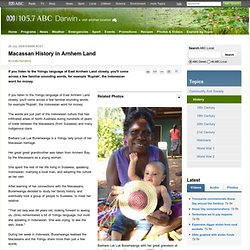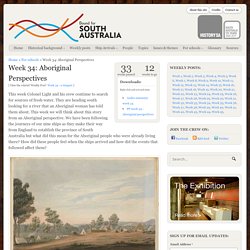

Macassan History in Arnhem Land - ABC Darwin - Australian Broadcasting Corporation. If you listen to the Yolngu language of East Arnhem Land closely, you'll come across a few familiar sounding words, for example 'Rupiah', the Indonesian word for money.

The words are just part of the Indonesian culture that has infiltrated areas of North Australia during hundreds of years of trade between the Macassans (from Sulawesi) and many Indigenous clans. Barbara Luk Luk Burarrwanga is a Yolngu lady proud of her Macassan heritage. Her great great grandmother was taken from Arnhem Bay by the Macassans as a young woman. She spent the rest of her life living in Sulawesi, speaking Indonesian, marrying a local man, and adopting the culture as her own. After learning of her connections with the Macassans, Burarrwanga decided to study her family history, and eventually took a group of people to Sulawesi, to meet her relative.
"That old lady was 99 years old, looking forward to seeing us. A blue, white and yellow flag is flown proudly in East Arnhem Land. "They didn't shoot. French navigators arrive in 'New Holland' 00:00:08:06NARRATOR:Seven months after leaving France, one morning, Baudin contemplates the true beginning of his mission.00:00:17:12NICOLAS BAUDIN:'At half past seven, the top men unfurling the sails told us of land lying east by north-east.'00:00:36:11MARTINE MARIN:You can imagine the excitement of a scientist, you know, after so much time being in the ship doing nothing because they couldn't work at anything.

And suddenly the coast was in sight.00:00:53:03NICOLAS BAUDIN:'At nine o'clock, we left to go ashore. All the scientists, as may easily be mentioned, wanted to be at the party. Index. Loved Up – Lore of Love (2005) clip 2 on ASO. Splash.abc.net. Transcript 00:00:00:00(Dramatic music)00:00:06:08(Melodious flute music)00:00:11:01MAN:19th of July 1770.

Employed in getting everything in readiness for sea. In the morning, we were visited by 10 or 11 of the natives. Most of them came from the other side of the river, where they saw seven or eight more, most of them women and, like the men, they were quite naked. Those that came on board were very desirous of having some of our turtles and took the liberty to haul two to the gangway to put over the side. Splash.abc.net. Twelve Canoes. Splash.abc.net. Pemulwuy - Barani. This engraving by James Grant of 'Pimbloy' is believed to be the only known depiction of Pemulwuy (illustration courtesy National Library of Australia, from Grant’s 'The narrative of a voyage of discovery, performed in His Majesty's vessel the Lady Nelson, of sixty tons burthen, with sliding keels, in the years 1800, 1801 and 1802, to New South Wales', 1803 - nla.cat-vn2312357) Pemulwuy was a courageous resistance fighter who led a guerrilla war against the British settlement at Sydney Cove from 1788 through to 1802.

Because of his resistance to the invaders, he became one of the most remembered and written about historical figures in Australian Aboriginal history. Pemulwuy was a Bidjigal man from the Botany Bay area of Sydney. He saw the damage done to Aboriginal society by the colonisers and was not tempted to befriend them as other Sydney Aboriginal people, including Arabanoo and Bennelong, had done.
Further reading. Early Contact. My Place Website. 1788 : Waruwi. Warning: This resource may contain references to Aboriginal and Torres Strait Islander people who may have passed away.

Waruwi is an Aboriginal girl looking after her Nana while the rest of her extended family is away from camp. It's just for a day but what a day it turns out to be. » Week 34: Aboriginal Perspectives » Bound for South Australia. This week Colonel Light and his crew continue to search for sources of fresh water.

They are heading south looking for a river that an Aboriginal woman has told them about. This week we will think about this story from an Aboriginal perspective. We have been following the journeys of our nine ships as they make their way from England to establish the province of South Australia but what did this mean for the Aboriginal people who were already living there? How did these people feel when the ships arrived and how did the events that followed affect them? Inquiry Questions: Colonel Light refers to several encounters with Aboriginal people. What evidence is there that Colonel Light is able to learn a lot about South Australia's landscape and environment through the knowledge, skills and lifestyles of the Aboriginal people? We have looked at the high level of importance Colonel Light placed on access to fresh water when selecting a site for the colony. Research Topics: Historical Skills: 1. 2.